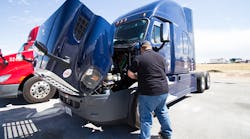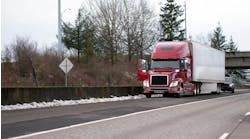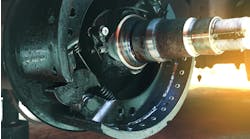Roadcheck 2019: Simple steps for improving your fleet’s safety
Editor’s note: This is the second part in a series leading up to International Roadcheck 2019. Read Part 1 and Part 3.
Pre- and post-trip inspections are vital for success with Level 1 inspections, according to Scott Dewey, manager of safety process and compliance at FedEx Freight. He recently told Fleet Owner that all of FedEx’s equipment adheres to a regular preventive maintenance schedule.
“By performing a proper vehicle inspection, drivers will be confident in the safety of their equipment for themselves as well as other drivers,” he said.
During inspections, drivers should use a flashlight to look at the chamber and slack adjusters, making sure none are loose or missing, said Keith McComsey, director of marketing and customer solutions, wheel-end for Bendix Spicer Foundation Brake. “For axles with parking brake chambers, check the pushrods to make sure they are extended equally. If not, you may have a broken power spring.”
Drivers should also watch their air pressure gauges on the dash.
Lee Sarratt, J.B. Hunt’s director of safety, pointed out roadside inspections can be a bit intimidating for less-experienced drivers. “They’ll get stressed out and forget simple things,” he said.
When there is a poor roadside inspection, the information goes into J.B. Hunt’s learning management hub. Drivers are then taken back through an automated training system, Sarratt said.
Zonar’s Electronic Verified Inspection Reporting system uses RFID tags to verify a pre- and post-trip inspection has been done. “The driver has a handheld tablet and scans that tag, and it tells them what to look at. They have to say if it is good or not,” Fred Fakkema, vice president of compliance at Zonar, explained.
Fakkema, who had a 25-year career with the Washington State Patrol, added that each tag is date or time-stamped so it can report how long drivers spent in a specific zone. “When the tablet is put in the docking station, it automatically sends info to the back office, and it can alert the mechanic or the safety director,” he said.
P&B Transport uses Zonar to monitor the points that drivers check. “We’re able to monitor what they’re doing and if they’re doing their inspections,” said Brian Telford, safety and compliance manager for the fleet.
Telford added that Zonar’s technology has helped P&B improve safety and eliminate downtime. Last year, out of 54 trucks that travel heavily into New York and New Jersey and pass two inspection stations on every trip, P&B only experienced two violations for drivers that made errors involving personal conveyance. “We had no mechanical violations and no log violations,” Telford said.
Zonar also provides codes alerting P&B to needed repairs. “Quite often, it isn’t necessarily something drivers have to pull over for, but it isn’t uncommon for our garage manager to order the part and when the driver gets back in the terminal, the mechanic changes it and the driver never even knew there was a problem,” Telford said.
Similarly, TripVision, a fleet asset management solution from Noregon Systems, alerts users in real time to vehicle issues that could affect safety or performance. It can make recommendations, such as rerouting to a service center, and remotely perform a forced regen, said Dave Covington, Noregon’s chief technology officer.
VPG Onboard Weighing, a brand of Vishay Precision Group Inc., manufactures weighing systems that capture information from inclinometers to ensure equipment is loaded correctly and determine if loads need to shift, said Richard Collins, global sales and marketing director.
“There is a touch screen display that can be mounted in the cab or the back of the van so the driver can see while he is loading the axle and what weight he has to move,” Collins said.
Another technology offering focused on tires is the Tire Optix management system from Goodyear Tire & Rubber. Johnny McIntosh, general manager of services and solutions, commercial tires, said the system collects data and immediately uploads information to a cloud-based platform with instant push reports for fleets.
McIntosh recommends fleets have a comprehensive tire management program to help identify issues before trucks ever leave the terminal.
This is the second part in a series leading up to International Roadcheck 2019. This week, we’ll look at how fleets can improve safety in advance of Roadcheck, along with the role technology plays, how roadside inspectors think and a deeper look at the inspection process. Read Part 1 and Part 3.



